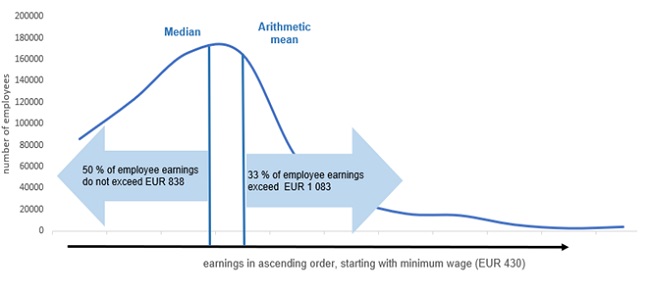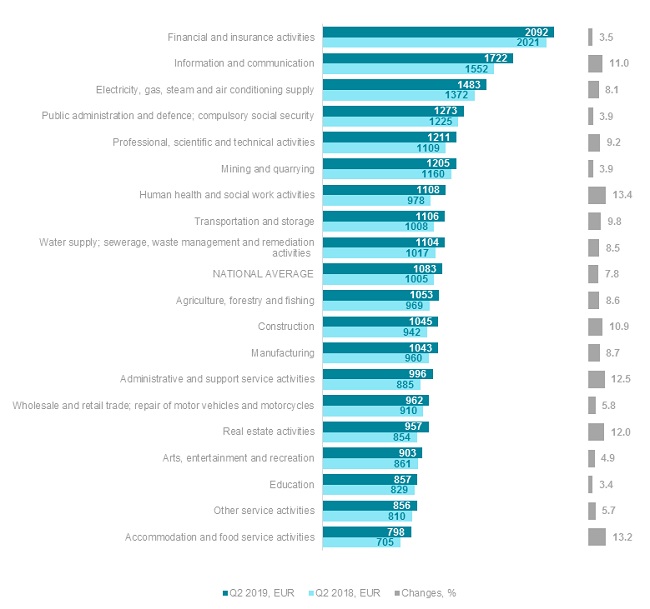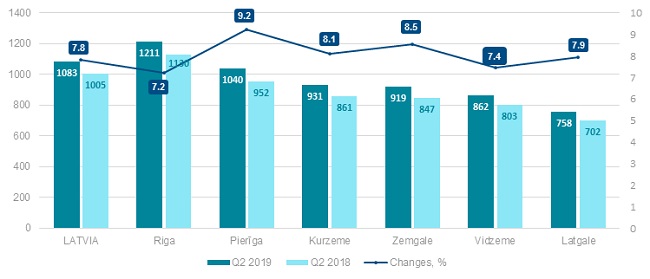Analytics, Baltic, Financial Services, Good for Business, Latvia, Wages
International Internet Magazine. Baltic States news & analytics
Wednesday, 17.12.2025, 07:36
In the 2nd quarter, average gross earnings in Latvia amounted to EUR 1 083
 Print version
Print versionCompared to the 1st quarter of 2019, in the 2nd quarter of 2019 gross wages and salaries grew by 4.6%.
Net earnings amounted to EUR 799
In the 2nd quarter of 2019, average net wages and salaries (calculated based on the labour taxes applicable at workplace) constituted EUR 799. Over the year, net earnings rose by 7.5%, while compared to the 1st quarter of 2019 they rose by 4.1%.
Considering annual consumer price growth of 3.3%, the real increase in net wages and salaries comprised 4.1%.
Median wages and salaries comprised EUR 838
In the 2nd quarter of 2019, median gross wages and salaries amounted to EUR 838, and, compared to the 2nd quarter of 2018 (when gross earnings constituted EUR 769), they grew faster than mean arithmetic earnings (rise of 9.1%). In the 2nd quarter of 2019, net median earnings (after taxes) constituted EUR 619 and rose by 8.7% over the year.
Median is calculated based on the information available in statistical surveys and administrative data of the State Revenue Service.
Median is an average indicator located in the middle of employee earnings sorted in an ascending or descending order. As median, compared to the mean arithmetic earnings, is not influenced by extremely high or low wages and salaries, it reflects typical earnings more precisely.

Sharper rise in earnings recorded in private sector
In the 2nd quarter of 2019, average monthly gross wages and salaries in public sector exceeded the indicator recorded in private sector – EUR 1 097 and EUR 1 079, respectively, however faster annual increase rate was registered in private sector – 8.9%, compared to 6.0% in public. Average earnings in general government sector, which includes central and local government institutions, as well as enterprises controlled and financed by the central and local government, grew to EUR 1 040 or by 5.7%.
Changes
in average monthly wages and salaries by sector*
(euros)
|
|
Q2 2018 |
Q1
2019 |
Q2 2019 |
Changes
in Q2 2019, as % compared to |
|
|
Q2 2018 |
Q1 2019 |
||||
|
Total |
1005 |
1036 |
1083 |
7.8 |
4.6 |
|
private sector |
991 |
1038 |
1079 |
8.9 |
40 |
|
public sector |
1035 |
1035 |
1097 |
6.0 |
6.0 |
|
general government sector |
984 |
985 |
1040 |
5.7 |
5.6 |
* Data on 2019 are provisional.
Changes in the average wages and salaries are influenced not only by the rise of employee remuneration, but also structural changes on the labour market – enterprises that had started and stopped their business during the year, changes in the number of employees and workloads in various economic sectors, as well as state administrative measures in the fight against the shadow economy. The effects caused by the mentioned factors in general may be seen in the changes in the wage and salary fund and number of full-time employees, which are used in the average wage calculations.
In the 2nd quarter of 2019, compared to the 2nd quarter of 2018, gross wage and salary fund increased by 8.2% or EUR 185.8 million, while the number of salaried workers, recalculated into full-time units, grew by 0.4% or 2.6 thousand.
In the 2nd quarter of 2019, the sharpest rise in earnings was recorded in human health and social work activities (of 13.4%). Increase in human health activities was influenced by the rise employee remuneration, whereas the upturn in social work activities without accommodation was affected by the decline in number of employees (of 10%) while wage and salary fund did not change. Over the year, average wages and salaries grew over 10% also in accommodation and food service activities (by 13.2%, it should be noted that this activity has the lowest average remuneration in the country), administrative and support service activities (12.5 % with sharper rise in rental and leasing activities; travel agency, tour operator reservation service and related activities; employment activities), real estate activities (12.0 %), information and communication (11.0%, with faster upturn in telecommunications and information service activities), as well as construction (10.9%).
Average earnings above the national average in nine economic activities
In the 2nd quarter of 2019, average wages and salaries for full-time work exceeded the national average indicator in nine economic activities out of 19 – financial and insurance activities, information and communication, energy sector, public administration, professional, scientific and technical activities, mining and quarrying, human health and social work activities, transportation and storage, as well as water supply; sewerage, waste management and remediation activities.
The lowest average wages and salaries, in turn, were observed in accommodation and food service activities, other service activities (that includes activities of public and other organisations, repair of computers and personal and household goods, washing and (dry-)cleaning, hairdressing and other beauty treatment, funeral and related activities), education, as well as arts, entertainment and recreation.
Average monthly gross wages and salaries in Q2 2018 and Q2 2019 and changes thereof by economic activity

Steeper rise in earnings observed in Pierīga
Compared to the 2nd quarter of 2018, in the 2nd quarter of 2019 regional breakdown shows the sharpest rise in the average monthly gross wages and salaries in Pierīga region (of 9.2%), followed by Zemgale (8.5%), and Kurzeme (of 8.1%). The annual rise in Riga, having the highest wages and salaries (EUR 1 211), was the smallest – 7.2 %. The lowest average gross wages and salaries for full-time work still were registered in Latgale region – EUR 758, constituting 70% of the national average.

Highest earnings in Estonia, while highest rise in Lithuania
In the 2nd quarter of 2019, the highest earnings among the Baltic states were registered in Estonia (EUR 1 419 for full-time work), while the lowest in Latvia (EUR 1 083). In Lithuania, where the social security contribution rates payable by employers and employees were changed as of 1 January 2019 and gross earnings were indexed 1.289 times, average earnings amounted to EUR 1 289. Compared to the 2nd quarter of the previous year, average wages and salaries have increased in all Baltic states. Excluding the indexing effect, the sharpest rise was recorded in Lithuania (of 7.9%), followed by Latvia (7.8%) and Estonia (7.4%).
This year, the highest minimum wage was registered in Lithuania (EUR 555), followed by Estonia (EUR 540), and Latvia (EUR 430).








 «The Baltic Course» Is Sold and Stays in Business!
«The Baltic Course» Is Sold and Stays in Business!

